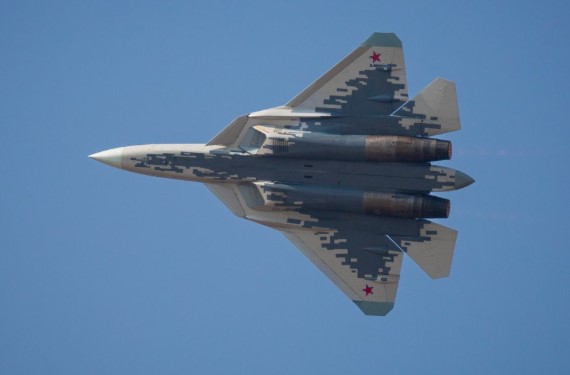Russia has added a dangerous new weapon to its stealth aircraft fleet. The country’s most advanced fighter jet, the Sukhoi Su-57, now officially carries two types of extremely powerful missiles — the hypersonic 3N-22 Zircon and the nuclear-capable KH-101/102.
Russia’s Stealth Fighter Now Carries Missiles That Can’t Be Matched
These upgrades give the jet an unmatched ability to strike targets thousands of kilometers away, far beyond the reach of any other fighter aircraft in the world today.
The 3N-22 Zircon missile ranks among the fastest missiles in the world. It travels at speeds up to Mach 9, or over 9,600 kilometers per hour. This hypersonic speed makes it almost impossible to intercept. Russia originally developed the Zircon for its Navy but has now modified it for air launch. The Su-57 currently stands as the only fighter jet known to carry this missile.
Alongside the Zircon, the Su-57 also carries a modified version of the KH-101 and KH-102 cruise missiles. These missiles can strike targets as far as 3,500 kilometers away. Russia uses the KH-101 for conventional attacks and the KH-102 to deliver nuclear warheads. Previously, large strategic bombers carried these missiles, but Russia has redesigned them to fit inside the Su-57’s internal weapons bay.
⚔️ Two fighters, two doctrines: Su-57 built to strike hard, F-22 to vanish before it’s seen
Engineers have adapted both the Zircon and KH-101/102 missiles with compact airframes and folding wings to fit them inside the Su-57. They also upgraded the missiles’ engines, including modifying the TRDD-50A turbofan engine for better performance.
What Makes the Su-57 More Dangerous Than Other Fighters
The addition of long-range, hypersonic, and nuclear-capable missiles to the Su-57 gives Russia a major advantage in aerial combat and long-distance strikes. Most fighter jets in service across the world today, including those operated by NATO and the United States, do not have the capability to strike targets thousands of kilometers away with nuclear payloads from a stealth aircraft.
The United States Navy, for example, uses the SM-6 missile (Standard Missile 6), which it launches against air threats and in anti-ship roles. However, Navy ships — not fighter aircraft — launch this missile. The SM-6 also offers lower range and speed compared to the Zircon missile. Meanwhile, most Western fighter aircraft carry only shorter-range missiles, which cannot reach the distances that Russia’s KH-101/102 missiles can cover.
Crippling US Sanctions Endanger SU-57 Fighter Jet Program of Russia
The Su-57 serves as a fifth-generation stealth fighter. Its designers built it to avoid detection by radar. With its new missile capabilities, the Su-57 can now approach enemy borders, launch missiles from a great distance, and leave the area before anyone even realizes it was there. This ability gives it a unique tactical role in modern warfare.
Larger aircraft like the Tu-160 Blackjack and the Tu-95 Bear-H bombers previously carried these missile systems. Adapting them for use on a stealth fighter like the Su-57 shows how far Russia has come in miniaturizing advanced weapon systems. This combination of stealth and strike range gives the Russian Air Force a new level of operational reach.
Production of Su-57 Jets Increases Despite Sanctions
Russia is increasing its production of the Su-57 fighter jet despite facing international sanctions and criticism. In 2024, Russia doubled the number of Su-57 aircraft delivered to its defense forces compared to the previous year. In 2024, Russia added 12 new Su-57 jets to its fleet, doubling the number from 6 in 2023.
The United Aircraft Corporation (UAC) builds the stealth fighter at its facility in the Russian Far East. Russia aims to deploy at least 76 of these jets by 2028. Despite facing economic pressure and global restrictions, the country continues to develop and field advanced military technology.
Russia has expanded the deployment of its fifth-generation stealth fighters in the conflict with Ukraine. Its forces are now testing and using these jets in actual combat, demonstrating not just technological advancement but real battlefield application. No other nation has previously launched hypersonic and nuclear-capable missiles from a stealth aircraft during an active conflict, placing this platform in a unique category among global fighter jets.
🇷🇺 Alaska in crosshairs: Russian Su-57 jets circle as U.S. relies on 1970s radar tech
Reports from early 2023 had already indicated that Russia was working on a new hypersonic missile for the Su-57. At the time, there was skepticism, especially in Western media, about the aircraft’s true stealth and fifth-generation capabilities. But with the confirmed integration of the 3N-22 Zircon and KH-101/102, these doubts are being replaced with concern over its real-world combat power.
The Su-57 is now more than just a stealth aircraft. With the ability to carry both the hypersonic Zircon missile and long-range nuclear KH-102 missiles, it has become a strategic asset capable of delivering powerful strikes from a safe distance. These changes make the aircraft a major part of Russia’s modern military force.

